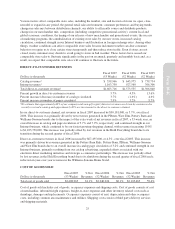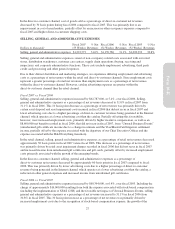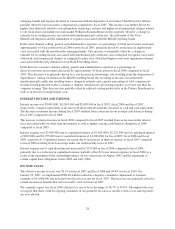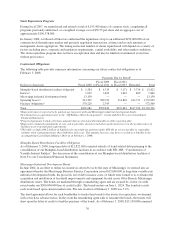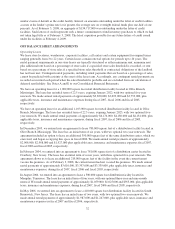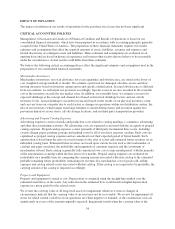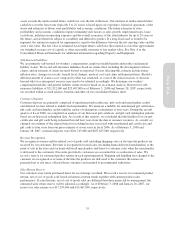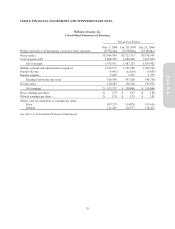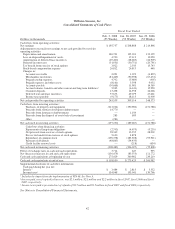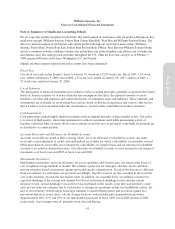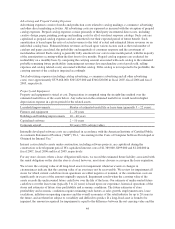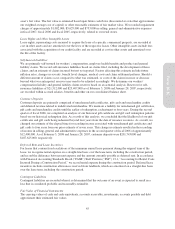Pottery Barn 2007 Annual Report Download - page 45
Download and view the complete annual report
Please find page 45 of the 2007 Pottery Barn annual report below. You can navigate through the pages in the report by either clicking on the pages listed below, or by using the keyword search tool below to find specific information within the annual report.
assets exceeds the undiscounted future cash flows over the life of the lease. Our estimate of undiscounted future
cash flows over the lease term (typically 5 to 22 years) is based upon our experience, historical operations of the
stores and estimates of future store profitability and economic conditions. The future estimates of store
profitability and economic conditions require estimating such factors as sales growth, employment rates, lease
escalations, inflation on operating expenses and the overall economics of the retail industry for up to 20 years in
the future, and are therefore subject to variability and difficult to predict. If a long-lived asset is found to be
impaired, the amount recognized for impairment is equal to the difference between the net carrying value and the
asset’s fair value. The fair value is estimated based upon future cash flows (discounted at a rate that approximates
our weighted average cost of capital) or other reasonable estimates of fair market value. See Note A to the
Consolidated Financial Statements for additional information regarding Property and Equipment.
Self-Insured Liabilities
We are primarily self-insured for workers’ compensation, employee health benefits and product and general
liability claims. We record self-insurance liabilities based on claims filed, including the development of those
claims, and an estimate of claims incurred but not yet reported. Factors affecting this estimate include future
inflation rates, changes in severity, benefit level changes, medical costs and claim settlement patterns. Should a
different amount of claims occur compared to what was estimated, or costs of the claims increase or decrease
beyond what was anticipated, reserves may need to be adjusted accordingly. We determine our workers’
compensation liability and general liability claims reserves based on an actuarial analysis. Reserves for self-
insurance liabilities of $21,512,000 and $23,407,000 as of February 3, 2008 and January 28, 2007, respectively,
are recorded within accrued salaries, benefits and other on our consolidated balance sheet.
Customer Deposits
Customer deposits are primarily comprised of unredeemed gift certificates, gift cards and merchandise credits
and deferred revenue related to undelivered merchandise. We maintain a liability for unredeemed gift certificates,
gift cards and merchandise credits until the earlier of redemption, escheatment or four years. During the second
quarter of fiscal 2006, we completed an analysis of our historical gift certificate and gift card redemption patterns
based on our historical redemption data. As a result of this analysis, we concluded that the likelihood of our gift
certificates and gift cards being redeemed beyond four years from the date of issuance is remote. As a result, we
changed our estimate of the elapsed time for recording income associated with unredeemed gift certificates and
gift cards to four years from our prior estimate of seven years in fiscal 2006. As of February 3, 2008 and
January 28, 2007, customer deposits were $201,743,000 and $187,625,000, respectively.
Revenue Recognition
We recognize revenues and the related cost of goods sold (including shipping costs) at the time the products are
received by our customers. Revenue is recognized for retail sales (excluding home-delivered merchandise) at the
point of sale in the store and for home-delivered merchandise and direct-to-customer sales when the merchandise
is delivered to the customers. Discounts provided to customers are accounted for as a reduction of sales. We
record a reserve for estimated product returns in each reporting period. Shipping and handling fees charged to the
customer are recognized as revenue at the time the products are delivered to the customer. Revenues are
presented net of any taxes collected from customers and remitted to governmental authorities.
Sales Return Reserve
Our customers may return purchased items for an exchange or refund. We record a reserve for estimated product
returns, net of cost of goods sold, based on historical return trends together with current product sales
performance. If actual returns, net of cost of goods sold, are different than those projected by management, the
estimated sales return reserve will be adjusted accordingly. As of February 3, 2008 and January 28, 2007, our
reserve for sales returns was $17,259,000 and $15,467,000, respectively.
35
Form 10-K


